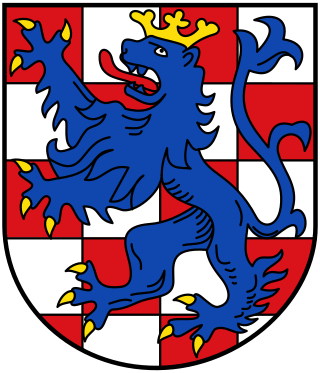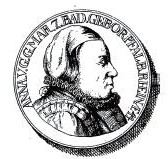
Salm is the name of several historic countships and principalities in present Germany, Belgium, Luxembourg and France.

The County Palatine of Veldenz was a principality in the contemporary Land Rhineland-Palatinate with full voting rights to the Reichstag. The county was located partially between Kaiserslautern, Sponheim and Zweibrücken, partially on the Mosel in the Archbishopric of Trier. A municipality of the same name, Veldenz, and a castle, Schloss Veldenz, are located in the district of Bernkastel-Wittlich.

Juliana, Countess of Stolberg-Wernigerode was the mother of William the Silent, the leader of the successful Dutch Revolt against the Spanish in the 16th century.

Philip Joseph, Prince of Salm-Kyrburg (1709–1779) was the first prince of Salm-Kyrburg, from 1743 to 1779.

The House of Salm was an ancient Lotharingian noble family originating from Salmchâteau in the Ardennes and ruling Salm. The dynasty is above all known for the experiences of the Upper Salm branch which came to be located at Château de Salm in the Vosges mountain range and over time came to rule over a principality whose capital was Badonviller then Senones.

Rupert was the Count of Veldenz from 1543 until 1544.
Countess Anna Magdalena von Hanau-Lichtenberg was a daughter of Count Johann Reinhard I of Hanau-Lichtenberg (1569–1625) and Countess Maria Elisabeth of Hohenlohe-Neuenstein-Weikersheim (1576–1605).
Countess Johanna Magdalene of Hanau-Lichtenberg was a daughter of Johann Reinhard II of Hanau-Lichtenberg (1628–1666) and the Countess Palatine Anna Magdalena of Birkenfeld-Bischweiler (1640–1693).

Otto Louis of Salm, Wild- and Rhinegrave of Kyrburg and Mörchingen was a Swedish general during the Thirty Years' War. He was governor in the Alsace and Commander of the Swedish troops in the Upper Rhine. He died of the plague at Speyer and was buried in Strasbourg Cathedral.

Countess Palatine Dorothea Catherine of Birkenfeld-Bischweiler was a Countess Palatine of Zweibrücken-Birkenfeld-Bischweiler by birth and, by marriage, Countess of Nassau-Ottweiler.

Frederick Louis of Nassau-Ottweiler was a member of the House of Nassau.
John IX of Salm-Kyrburg-Mörchingen (1575–1623) was Wild- and Rhinegrave of Kyrburg and Count of Salm. He was the son of Otto I (1538–1607) and Ottilie of Nassau-Weilburg. Many of his relatives served as soldiers in Swedish service, including his brother John Casimir of Salm-Kyrburg (1577–1651). Because of this, the family was often on the run during the Thirty Years' War.

Countess Palatine Anna of Veldenz was Margravine of Baden-Durlach by marriage to Charles II, Margrave of Baden-Durlach, and co-regent of the Margraviate of Baden-Durlach during the minority of her son Ernest Frederick from 1577 to 1584.

John, Count Palatine of Gelnhausen was Count Palatine and Duke of Zweibrücken-Birkenfeld at Gelnhausen.
Diana Dorothea of Salm was the daughter of Wild- and Rhinegrave John IX of Salm-Kyrburg-Mörchingen and his wife, Baroness Anna Catherine of Criechingen and Puttigny. An hour after her birth, her twin sister Anna Amalia, later Countess of Königseck, was born.
Wirich VI, Count of Daun-Falkenstein was a German nobleman, diplomat, statesman, and politician. By descent, he was a Count of Falkenstein, and by inheritance, he was Lord of Broich and Lord of Bürgel. He belonged to the lower nobility in the Duchy of Berg and was a member of the Estates of Berg. He supported the Reformation in the Lower Rhine area.

Count William Wirich of Daun-Falkenstein was a German nobleman. By descent, he was a Count of Falkenstein; by inheritance, he was Lord of Broich and Bürgel.

Countess Agatha Christine of Hanau-Lichtenberg was a daughter of Count Philip Wolfgang (1595-1641) and his wife, Countess Johanna of Oettingen (1602-1639).
Countess Agatha Marie of Hanau-Lichtenberg was a daughter of Count Johann Reinhard I (1569-1625) and his wife, Countess Maria Elisabeth of Hohenlohe-Neuenstein (1576-1605).
Countess Johanna of Hanau-Münzenberg was a daughter of Count Albert of Hanau-Münzenberg-Schwarzenfels and Countess Ehrengard of Isenburg. Hanau-Münzenberg-Schwarzenfels was a cadet branch of Hanau-Münzenberg.












